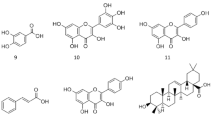Abstract
Field inquiries and organoleptic tests for sweet taste led to the procurement of samples ofPiper marginatum (dried leaves),Tagetes filicifolia (fresh whole plants),Osmorhiza longistylis (fresh roots),Foeniculum vulgare (fresh aerial parts),Myrrhis odorata (fresh whole plants),Ocimum basilicum (fresh aerial parts), andIllicium verum (dried fruits). Follow-up laboratory studies of the leaves ofPiper marginatum demonstrated that trans-anethole (a phenylpropanoid) was the major sweet constituent of this species. In the remaining six species, GC/MS analysis also enabled us to demonstrate that sweetness is attributable, in each case, to the presence of high concentrations of the phenylpropanoids, trans-anethole and estragole, either alone or in combination.
Resumen
Entrevistas y busqueda en el campo seguidas por pruebas organolépticas para detectar el sabor dulce nos dirigieron a la adquisición de muestras dePiper marginatum (hojas secas),Tagetes filicifolia (plantas enteras secas), Osmorhiza longistylis (raices frescas),Foeniculum vulgare (partes aéreas frescas),Myrrhis odorata (plantas enteras frescas),Ocimum basilicum (partes aéreas frescas), eIllicium verum (frutas secas). Estudios de laboratorio posterioresde las hojas dePiper marginatum demostraron quetrans-anetol (un fenilpropanoide) fué el principio edulcorante mayor de esta especie. En las seis especies restantes, el análisis por medio de la cromatografía gaseosa y espectrometría de masa nos permitieron a demostrar que el sabor dulce se debe tambien, en cada caso, a la presencia de altas concentraciones de fenilpropanoides, a sabertrans-anetol y estragol, tanto sólo como en conjunto.
Similar content being viewed by others
Literature Cited
Arctander, S. 1969. Perfume and flavor chemicals. Vol. 1. Published by the author, Montclair, NJ.
Caldwell, J., and J. D. Sutton. 1988. Influence of dose size on the disposition oftrans-[-methoxy-14C]anethole in human volunteers. Food Chem. Toxicol. 26:87–91.
Carro de la Torre, P. C, and J. A. Retamar. 1973. Essential oils of Tucuman province. Essence ofTagetes minuta. Arch. Bioquim. 18:39–42. (Original not seen; abstract in Chem. Abstr. 83: 183286d. 1975.)
Colombo, E., and P. Manitto. 1971. Huile essentielle d’anis badiane. Parfums Cosmet. Savons France 1:347–350.
Compadre, C. M., R. A. Hussain, R. L. Lopez de Compadre, J. M. Pezzuto, and A. D. Kinghorn. 1987. The intensely sweet sesquiterpene, hernandulcin: isolation, synthesis, characterization, and preliminary safety evaluation. J. Agric. Food Chem. 35:273–279.
Drinkwater, N. R., E. C. Miller, J. A. Miller, and H. C. Pitot. 1976. Hepatocarcinogenicity of estragole (l-allyl-4-methoxybenzene) and l’-hydroxyestragole in the mouse and mutagenicity of l’-ace- toxyestragole in bacteria. J. Natl. Cancer Inst. 57:1323–1331.
Fullas, F., J. Kim, C. M. Compadre, and A. D. Kinghorn. 1989. Separation of natural product sweetening agents using overpressured layer chromatography. J. Chromatogr. 464:213–219.
Furia, T. E., and N. Bellanca, ed. 1975. Fenaroli’s handbook of flavor ingredients. 2nd ed. Vol. 1, 2. CRC Press, Cleveland, OH.
Guenther, E. 1950. The essential oils. Vol. 4. Van Nostrand, New York.
Gupta, Y. N., and K. S. Bhandari. 1975. Essential oil from the leaves ofTagetes minuta. Indian Perfum. 19:29–32. (Original not seen; abstract in Chem. Abstr. 87:90579u. 1977.)
Heller, S. R., and G. W. A. Milne. 1978. EPA/NIH mass spectral database. Vol. 2. U.S. Department of Commerce, Washington, DC.
—, and — 1980. EPA/NIH mass spectral database, Suppl. 1. U.S. Department of Commerce, Washington, DC.
Hussain, R. A., J. Kim, T.-W. Hu, J. M. Pezzuto, D. D. Soejarto, and A. D. Kinghorn. 1986. Isolation of a highly sweet constituent fromCinnamomum osmophloeum leaves. Pl. Med. 52:403–404.
—, A. D. Kinghorn, and D. D. Soejarto. 1988. Sweetening agents of plant origin: literature search for candidate sweet plants. Econ. Bot. 42:267–283.
Inglett, G. E. 1982. Unusual sweeteners of plant origin. Herbarist 48:67–78.
Kinghorn, A. D. 1983. Carcinogenic and cocarcinogenic toxins from plants. Pages 239–298in R. F. Keeler and A. T. Tu, eds., Handbook of natural toxins. Vol. 1. Plant toxins. Marcel Dekker, New York.
—, and D. D. Soejarto. 1986. Sweetening agents of plant origin. CRC Crit. Rev. PL Sci. 4:76–120.
Lawrence, B. M., R. H. Powell, T. W. Smith, and S. Kramer. 1986. Chemical composition ofTagetes oil. Perfum. Flavor. 10(6):56–58. (Original not seen; abstract in Chem. Abstr. 104:95246n. 1986.)
Nanayakkara, N. P. D., R. A. Hussain, J. M. Pezzuto, D. D. Soejarto, and A. D. Kinghorn. 1988. An intensely sweet dihydroflavonol derivative based on a natural product lead compound. J. Med. Chem. 31:1250–1253.
Naves, Y.-R., P. Ardizio, and C. Favre. 1958. Étude sur les matières végétales volatiles, CL (I). Isolement et caractérization ducis-anéthole. Bull. Soc. Chim. France 1958:566–569.
Pezzuto, J. M., C. M. Compadre, S. M. Swanson, N. P. D. Nanayakkara, and A. D. Kinghorn. 1985. Metabolically activated steviol, the aglycone of stevioside, is mutagenic. Proc. Natl. Acad. U.S.A. 82:2478–2482.
Poveda, L. J. 1986. Hoja de estrella. Lo maravilloso de nuestra flora medicamentosa. Biocenosis 2: 36–38.
Ramos, L. S., M. L. da Silva, A. I. R. Luz, M. G. B. Zoghbi, and J. G. S. Maia. 1986. Essential oil ofPiper marginatum. J. Nat. Prod. 49:712–713.
Sawicka, W. 1969.Myrrhis odorata as a source of anethole. I. Essential oil content in various organs ofMyrrhis odorata. Acta Pol. Pharm. 26:565–568. (Original not seen; abstract in Chem. Abstr. 72:107780t. 1970.)
Skaltsa, H., and A. Loukis. 1986. Analysis of the essential oil of Greek sweet basil. PL Med. 52 (Suppl.):50–51.
Soejarto, D. D., C. M. Compadre, P. J. Medon, S. K. Kamath, and A. D. Kinghorn. 1983. Potential sweetening agents of plant origin. II. Field search for sweet tastingStevia species. Econ. Bot. 37:71–79.
—, A. D. Kinghorn, and N. R. Farnsworth. 1982. Potential sweetening agents of plant origin. III. Organoleptic evaluation of leaf herbarium samples for sweetness. J. Nat. Prod. 45:590–599.
Author information
Authors and Affiliations
Additional information
Part 18 in the series “Potential sweetening agents of plant origin.” For part 17, see Fullas et al. (1989).
Rights and permissions
About this article
Cite this article
Hussain, R.A., Poveda, L.J., Pezzuto, J.M. et al. Sweetening agents of plant origin: Phenylpropanoid constituents of seven sweet-tasting plants. Econ Bot 44, 174–182 (1990). https://doi.org/10.1007/BF02860485
Received:
Accepted:
Issue Date:
DOI: https://doi.org/10.1007/BF02860485




